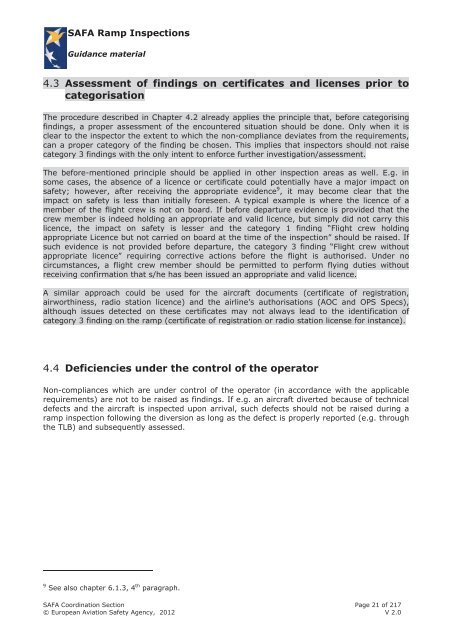SAFA Ramp Inspections - Code7700
SAFA Ramp Inspections - Code7700
SAFA Ramp Inspections - Code7700
You also want an ePaper? Increase the reach of your titles
YUMPU automatically turns print PDFs into web optimized ePapers that Google loves.
<strong>SAFA</strong> <strong>Ramp</strong> <strong>Inspections</strong>Guidance material4.3 Assessment of findings on certificates and licenses prior tocategorisationThe procedure described in Chapter 4.2 already applies the principle that, before categorisingfindings, a proper assessment of the encountered situation should be done. Only when it isclear to the inspector the extent to which the non-compliance deviates from the requirements,can a proper category of the finding be chosen. This implies that inspectors should not raisecategory 3 findings with the only intent to enforce further investigation/assessment.The before-mentioned principle should be applied in other inspection areas as well. E.g. insome cases, the absence of a licence or certificate could potentially have a major impact onsafety; however, after receiving the appropriate evidence 9 , it may become clear that theimpact on safety is less than initially foreseen. A typical example is where the licence of amember of the flight crew is not on board. If before departure evidence is provided that thecrew member is indeed holding an appropriate and valid licence, but simply did not carry thislicence, the impact on safety is lesser and the category 1 finding “Flight crew holdingappropriate Licence but not carried on board at the time of the inspection” should be raised. Ifsuch evidence is not provided before departure, the category 3 finding “Flight crew withoutappropriate licence” requiring corrective actions before the flight is authorised. Under nocircumstances, a flight crew member should be permitted to perform flying duties withoutreceiving confirmation that s/he has been issued an appropriate and valid licence.A similar approach could be used for the aircraft documents (certificate of registration,airworthiness, radio station licence) and the airline’s authorisations (AOC and OPS Specs),although issues detected on these certificates may not always lead to the identification ofcategory 3 finding on the ramp (certificate of registration or radio station license for instance).4.4 Deficiencies under the control of the operatorNon-compliances which are under control of the operator (in accordance with the applicablerequirements) are not to be raised as findings. If e.g. an aircraft diverted because of technicaldefects and the aircraft is inspected upon arrival, such defects should not be raised during aramp inspection following the diversion as long as the defect is properly reported (e.g. throughthe TLB) and subsequently assessed.9 See also chapter 6.1.3, 4 th paragraph.<strong>SAFA</strong> Coordination Section Page 21 of 217© European Aviation Safety Agency, 2012 V 2.0
















